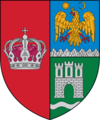Hoghiz
Hoghiz
Olthévíz | |
|---|---|
 View from Ungra of Castra of Hoghiz | |
 Location within the county | |
| Coordinates: 45°59′N 25°18′E / 45.983°N 25.300°E | |
| Country | Romania |
| County | Brașov |
| Government | |
| • Mayor (2020–2024) | Ioan Buta (PSD) |
| Area | 178.38 km2 (68.87 sq mi) |
| Elevation | 479 m (1,572 ft) |
| Population (2021-12-01)[1] | 4,896 |
| • Density | 27/km2 (71/sq mi) |
| Time zone | EET/EEST (UTC+2/+3) |
| Postal code | 507095 |
| Area code | (+40) 02 68 |
| Vehicle reg. | BV |
| Website | www |

Hoghiz (German: Warmwasser; Hungarian: Hévíz or Olthévíz) is a commune in Brașov County, Transylvania, Romania. It is composed of six villages: Bogata Olteană (Oltbogát), Cuciulata (Katscheloden; Kucsuláta), Dopca (Dopich; Datk), Fântâna (Olthidegkút), Hoghiz and Lupșa (Lupsa).
Geography
[edit]The commune is situated on the Transylvanian Plateau, on the left bank of the Olt River. It is located in the northern part of the county, 10 km (6.2 mi) from the town of Rupea and 56 km (35 mi) from the county seat, Brașov.
Demographics
[edit]At the 2011 census, 68.4% of inhabitants were Romanians, 27.8% Hungarians and 3.6% Roma. At the 2002 census, 66.4% were Romanian Orthodox, 17.6% Unitarian, 8.4% Reformed, 3.1% Pentecostal and 2.8% Roman Catholic.
Natives
[edit]- Viorel Morariu (1931–2017), rugby union player
- Aron Pumnul (1818–1866), philologist, teacher, and national and revolutionary activist
Villages
[edit]Cuciulata
[edit]
The village of Cuciulata was first attested in a document of 1372 as Vila Roczolod. It also appears as Kucsalota (1589), Kucstulata (1637) and Kociulata (1648). It is located on the south banks of Olt River at the base of the Perșani Mountains, and is crossed by Lupșa Creek. The road DJ104 passes through the village center and DC20 road connects Cuciulata to Lupșa village. Archaeological excavations have shown the existence of a settlement in this place in the Bronze Age. The ruins of a 1st-century BC Dacian stronghold have also been discovered. Among the monuments in the village are a wooden church dating from 1700-1752 and a stone Orthodox church from 1784 to 1791.
See also
[edit]


